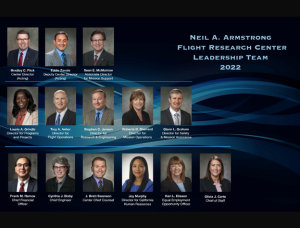Armstrong Flight Research Center (AFRC)
The Armstrong Flight Research Center (AFRC) is NASA’s foremost center for atmospheric flight research and test projects. The center’s location at Edwards Air Force Base, California in the Mojave Desert provides excellent year-round flying weather in a remote area.[1]
In partnership with the Johnson Space Center and Lockheed Martin, AFRC managed the launch abort systems testing and integration for the Orion Multi-Purpose Crew Vehicle. NASA sources note that Orion Ascent Abort (AA)-2 launched July 2, 2019, which marked a milestone in NASA’s preparation for Artemis missions to the Moon. The flight operations of Stratospheric Observatory for Infrared Astronomy (SOFIA) program are managed by AFRC in partnership with the Ames Research Center and the German Aerospace Center. The SOFIA program observes space through a 37,500-pound telescope aboard a Boeing 747SP aircraft. [2] AFRC runs a fleet of aircrafts (C-20A, B200, DC-8, ER-2) for Earth science missions under the Airborne Science Program. Current or recent projects from the Airborne Science Program include:
- “Studying atmospheric effects of wildland and agricultural fires in U.S.
- Gathering data over specified areas repeatedly over time to gather data for geological studies
- Improving snowfall remote sensing interpretation and modeling to advance predictive capabilities”[3]
AFRC’s management of the Flight Opportunities program supports space technology development. Through this program, suborbital testing with industry providers allows technology demonstration for space commerce and exploration. Armstrong’s facilities include the Research Aircraft Integration Facility, the Science Operations Building 703 in Palmdale, the Consolidated Information Technology Center, Experimental Fabrication and Repair, the Flight Loads Laboratory, and the Research Aircraft Integration Facility. Backup communications for the International Space Station and the Russian Soyuz spacecraft have been provided by the Dryden Aeronautical Test Range for decades.[4]
The Armstrong Flight Research Center leadership team is shown below.

Source: NASA
AFRC published a Strategic Plan in 2015 that sets out goals and initiatives for the Center’s future. The 2020 AFRC Strategic Plan can be accessed here.
Information on doing business with AFRC is available here.
AFRC’s Research, Technology, and Engineering Report published in 2021 is available here.
Updated by Jackie Johnson, October 2022

Comments are closed.